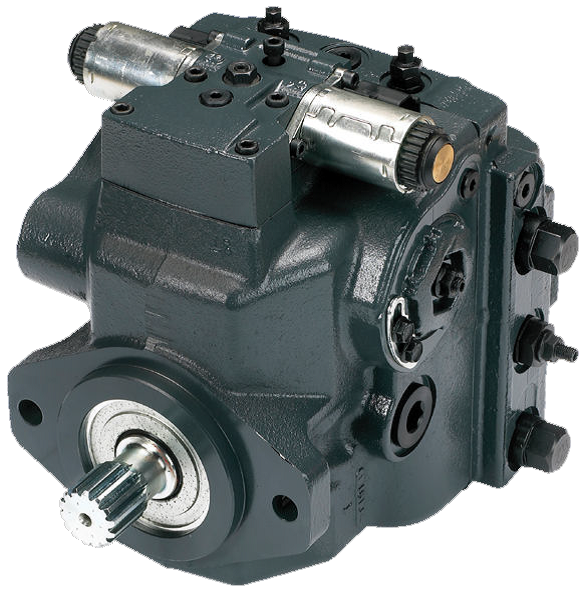Flow pulsation frequency and its management strategies in hydraulic pump systems
The frequency of instantaneous flow pulsations in a hydraulic pump system is affected by a variety of factors, including pump design, operating conditions, and characteristics of the fluid being pumped. Pulsation frequency refers to the rate at which pressure fluctuations or pulses occur in hydraulic oil.
Several factors affect flow pulsation frequency:
1. Number of pump piston or gear teeth:
In positive displacement pumps, such as piston pumps or gear pumps, the number of piston or gear teeth affects the pulsation frequency. More pistons or teeth can result in a higher pulsation frequency.
2. Pump speed:
The speed of the pump affects the frequency of the pressure pulses. Higher pump speeds usually result in higher pulsation frequencies.
3. Fluid characteristics:
The characteristics of the hydraulic oil, such as viscosity and compressibility, affect the pulsation frequency. Different fluids may exhibit different pulsation characteristics.
4. System design:
The design of the entire hydraulic system, including the size and configuration of pipes, valves, and other components, affects pulsation frequency.
H1-P-100-R-A-A-A4-C2-N-D6-H-G9-H5-L-42-L-42-M-L-28-PN-NNN-NNN H1P100RAAA4C2ND6HG9H5L42L42ML28PNNNNNNN
H1-P-100-R-A-A-A4-C2-N-D3-H-G9-H5-L-42-L-42-M-M-24-PN-NNN-NNN H1P100RAAA4C2ND3HG9H5L42L42MM24PNNNNNNN
H1-P-100-R-A-A-A4-C2-N-D3-H-G9-H3-L-42-L-42-D-M-20-PN-NNN-NNN H1P100RAAA4C2ND3HG9H3L42L42DM20PNNNNNNN
H1-P-100-R-A-A-A4-C2-N-D3-H-G1-H3-L-42-L-42-M-M-24-PN-NNN-NNN H1P100RAAA4C2ND3HG1H3L42L42MM24PNNNNNNN
H1-P-100-R-A-A-A4-C2-N-D3-H-G1-H3-L-35-L-35-D-M-24-PN-NNN-NNN H1P100RAAA4C2ND3HG1H3L35L35DM24PNNNNNNN
H1-P-100-R-A-A-A4-C2-N-D3-H-G1-H3-L-33-L-33-M-M-24-PN-NNN-NNN H1P100RAAA4C2ND3HG1H3L33L33MM24PNNNNNNN
H1-P-100-R-A-A-A4-C2-N-D3-H-G1-H3-K-45-K-45-D-M-22-PN-NNN-NNN H1P100RAAA4C2ND3HG1H3K45K45DM22PNNNNNNN
H1-P-100-R-A-A-A4-C2-N-D3-H-G1-H2-L-42-L-42-D-M-24-PN-NNN-NNN H1P100RAAA4C2ND3HG1H2L42L42DM24PNNNNNNN
H1-P-100-R-A-A-A4-C2-N-D3-H-F4-H3-L-42-L-42-D-M-18-PN-NNN-NNN H1P100RAAA4C2ND3HF4H3L42L42DM18PNNNNNNN
H1-P-100-R-A-A-A4-C2-N-D3-H-F1-H3-L-42-L-42-D-M-20-PN-NNN-NNN H1P100RAAA4C2ND3HF1H3L42L42DM20PNNNNNNN
H1-P-100-R-A-A-A4-C2-B-D8-H-G1-NN-L-35-L-35-D-P-24-PN-NNN-NNN H1P100RAAA4C2BD8HG1NNL35L35DP24PNNNNNNN
H1-P-100-R-A-A-A4-C2-B-D6-H-F4-H2-K-40-K-40-M-L-22-PN-NNN-NNN H1P100RAAA4C2BD6HF4H2K40K40ML22PNNNNNNN
H1-P-100-R-A-A-A4-C2-B-D3-H-G1-NN-L-38-L-38-M-M-26-PN-NNN-NNN H1P100RAAA4C2BD3HG1NNL38L38MM26PNNNNNNN
H1-P-100-R-A-A-A4-C2-B-D3-H-G1-NN-L-30-L-30-M-M-24-PN-NNN-NNN H1P100RAAA4C2BD3HG1NNL30L30MM24PNNNNNNN
H1-P-100-R-A-A-A4-C1-N-F6-H-G9-H6-L-45-L-45-M-L-24-PN-NNN-NNN H1P100RAAA4C1NF6HG9H6L45L45ML24PNNNNNNN
H1-P-100-R-A-A-A4-C1-N-F6-H-G9-H6-L-42-L-42-M-L-24-PN-NNN-NNN H1P100RAAA4C1NF6HG9H6L42L42ML24PNNNNNNN
H1-P-100-R-A-A-A4-C1-N-F6-H-G9-H6-L-30-L-30-M-L-24-PN-NNN-NNN H1P100RAAA4C1NF6HG9H6L30L30ML24PNNNNNNN
H1-P-100-R-A-A-A4-C1-N-F5-H-F1-H6-L-45-L-45-M-P-26-PN-NNN-NNN H1P100RAAA4C1NF5HF1H6L45L45MP26PNNNNNNN
H1-P-100-R-A-A-A4-C1-N-F4-H-G9-H6-L-25-L-25-M-M-24-PN-NNN-NNN H1P100RAAA4C1NF4HG9H6L25L25MM24PNNNNNNN
H1-P-100-R-A-A-A4-C1-N-F4-H-G3-H6-K-35-K-35-M-M-20-PN-NNN-NNN H1P100RAAA4C1NF4HG3H6K35K35MM20PNNNNNNN
5. Operating conditions:
Factors such as load changes and changes in operating conditions can affect the pulsation frequency. For example, the frequency may change when the pump is operated at different pressures or flows.
Further elaborating on strategies for managing flow pulsations in hydraulic systems:
1. Accumulator:
An accumulator is a device used to store hydraulic energy under pressure. They can act as a buffer to absorb pulsations and provide a more consistent flow. This is particularly important for systems with variable loads, where the demand for hydraulic oil may fluctuate.
2. Damper:
Pulsation dampers or damping devices can be installed in hydraulic systems to eliminate pressure fluctuations. These devices typically contain a flexible element, such as a diaphragm or bladder, that absorbs and dampens sudden pressure changes.
3. Correct size and selection:
Ensuring components such as pipes, valves and hoses are sized appropriately for the application will help minimize pulsation. Undersized components can cause pressure spikes and flow irregularities.
4.Pump design:
Pump manufacturers often design pumps with pulsation reduction capabilities. This can include using multiple pistons or gears to distribute the load more evenly and minimize pressure changes.

5. Control valve:
Using appropriate control valves, especially proportional or servo valves, can help regulate flow and pressure more smoothly, reducing the potential for pulsation.
6. Monitor and adjust operating conditions:
Regularly monitoring system performance can help identify conditions that cause pulsations. Adjusting parameters such as pump speed, pressure settings, or load conditions may help optimize system performance.
7.Feedback control system:
Using a feedback control system, the pump speed or other operating parameters can be adjusted in real time based on system conditions, helping to maintain more stable flow and pressure. This type of control can be achieved through the use of sensors and electronic control systems.
8. System modeling and simulation:
Engineers often use computer modeling and simulation tools to analyze the behavior of hydraulic systems before implementation. This allows potential pulsation issues to be predicted and system design optimized before physical implementation.
9. Fluid damping:
Hydraulic oil selection affects pulsation. Higher viscosity fluids suppress pressure fluctuations better than lower viscosity fluids. However, the choice of fluid viscosity should be balanced with other operating requirements.
H1-P-100-R-A-A-A4-C1-N-D8-H-G1-NN-L-33-L-33-D-P-20-PN-NNN-NNN H1P100RAAA4C1ND8HG1NNL33L33DP20PNNNNNNN
H1-P-100-R-A-A-A4-C1-N-D8-H-G1-NN-L-25-L-25-M-P-24-PN-NNN-NNN H1P100RAAA4C1ND8HG1NNL25L25MP24PNNNNNNN
H1-P-100-R-A-A-A4-C1-N-D6-H-G9-H3-L-35-L-35-D-L-24-PN-NNN-NNN H1P100RAAA4C1ND6HG9H3L35L35DL24PNNNNNNN
H1-P-100-R-A-A-A4-C1-N-D6-H-G9-H3-L-30-L-30-M-L-24-PN-NNN-NNN H1P100RAAA4C1ND6HG9H3L30L30ML24PNNNNNNN
H1-P-100-R-A-A-A4-C1-N-D6-H-G1-H5-L-42-L-42-M-L-24-PN-NNN-NNN H1P100RAAA4C1ND6HG1H5L42L42ML24PNNNNNNN
H1-P-100-R-A-A-A4-C1-N-D6-H-G1-H2-L-42-L-42-M-L-24-PN-NNN-NNN H1P100RAAA4C1ND6HG1H2L42L42ML24PNNNNNNN
H1-P-100-R-A-A-A4-C1-B-F4-H-G9-H6-L-25-L-25-M-M-24-PN-NNN-NNN H1P100RAAA4C1BF4HG9H6L25L25MM24PNNNNNNN
H1-P-100-R-A-A-A4-C1-B-D6-H-G9-H3-L-35-L-35-D-L-30-PN-NNN-NNN H1P100RAAA4C1BD6HG9H3L35L35DL30PNNNNNNN
H1-P-100-R-A-A-A3-C3-N-D3-H-G1-NN-L-35-L-35-M-M-24-PN-NNN-NNN H1P100RAAA3C3ND3HG1NNL35L35MM24PNNNNNNN
H1-P-100-R-A-A-A3-C3-N-D3-H-G1-H3-L-42-L-42-M-M-28-PN-NNN-NNN H1P100RAAA3C3ND3HG1H3L42L42MM28PNNNNNNN
H1-P-100-R-A-A-A3-C2-N-F6-K-G1-H6-L-40-L-40-M-L-24-P4-NNN-NNN H1P100RAAA3C2NF6KG1H6L40L40ML24P4NNNNNN
H1-P-100-R-A-A-A3-C2-N-F5-H-G9-H6-K-42-K-42-D-P-34-PN-NNN-NNN H1P100RAAA3C2NF5HG9H6K42K42DP34PNNNNNNN
H1-P-100-R-A-A-A3-C2-N-F5-H-G1-H6-K-42-K-42-D-P-34-PN-NNN-NNN H1P100RAAA3C2NF5HG1H6K42K42DP34PNNNNNNN
H1-P-100-R-A-A-A3-C2-N-F4-K-G9-H6-L-40-L-40-M-M-24-P4-NNN-NNN H1P100RAAA3C2NF4KG9H6L40L40MM24P4NNNNNN
H1-P-100-R-A-A-A3-C2-N-D8-H-G1-H2-L-35-L-35-M-P-24-PN-NNN-NNN H1P100RAAA3C2ND8HG1H2L35L35MP24PNNNNNNN
H1-P-100-R-A-A-A3-C2-N-D8-H-F4-NN-L-30-L-15-M-P-18-PN-NNN-NNN H1P100RAAA3C2ND8HF4NNL30L15MP18PNNNNNNN
H1-P-100-R-A-A-A3-C2-N-D8-H-F1-H3-L-38-L-38-D-P-20-PN-NNN-NNN H1P100RAAA3C2ND8HF1H3L38L38DP20PNNNNNNN
H1-P-100-R-A-A-A3-C2-N-D6-H-F1-H2-L-25-L-25-D-L-30-PN-NNN-NNN H1P100RAAA3C2ND6HF1H2L25L25DL30PNNNNNNN
H1-P-100-R-A-A-A3-C2-N-D3-H-G9-NN-L-42-L-42-M-N-24-PN-NNN-NNN H1P100RAAA3C2ND3HG9NNL42L42MN24PNNNNNNN
H1-P-100-R-A-A-A3-C2-N-D3-H-G9-NN-L-42-L-42-M-M-24-PN-NNN-NNN H1P100RAAA3C2ND3HG9NNL42L42MM24PNNNNNNN
10. Maintenance practices:
Regular maintenance, including inspection and replacement of worn parts, is critical to preventing problems that can cause flow pulsations. This includes checking seals, valves and other critical components for signs of wear or damage.
11. Noise reduction measures:
Flow pulsations can cause increased noise levels in hydraulic systems. In applications where noise is a concern, it is important to adopt noise reduction measures such as using sound-absorbing materials or installing noise-reducing components.
12. Training and Operator Awareness:
Proper training of system operators is critical. Operators who understand the dynamics of the system and understand how its behavior affects flow and pressure fluctuations are better able to operate the system efficiently.
13. Testing and verification:
Thorough testing and verification of hydraulic systems under various operating conditions can help identify and resolve potential pulsation issues before the system is placed in service.
Every hydraulic system is unique, and the method of managing flow pulsations should be customized to its specific requirements and constraints. Collaboration between hydraulic system designers, manufacturers, and end users is critical to developing effective strategies to minimize flow pulsations and optimize system performance.
This article is published by the official website of Baolilai Hydraulics, please contact the author and indicate the source for reprinting:https://www.baolilai-pump.cn/news/1153.html






